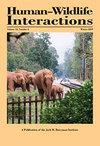Tolerance of Bearded Vultures to Human Activities: Response to Comor et al. (2019)
IF 0.9
4区 环境科学与生态学
Q4 BIODIVERSITY CONSERVATION
引用次数: 1
Abstract
: The bearded vulture ( Gypaetus barbatus ) is listed as vulnerable in Europe on the International Union for Conservation of Nature Red List because of population declines over multiple generations. Vulture population declines have been attributed to shooting, use of toxicants, and changes in land use, which have resulted in habitat degradation and increased anthropogenic disturbances. Concomitantly, conservation authorities have restricted practices deemed harmful to the species and have established protection buffers around occupied vulture breeding sites to mitigate the impacts of anthropogenic disturbances on breeding success. Comor et al. (2019) compared bearded vulture breeding success over 6 years within and outside areas with restricted activities in the western French Pyrenees and assessed distances between vultures and hunting parties. They concluded that hunting was not a threat to species conservation and may even benefit vultures by providing alternative food resource. We dispute the conclusions of Comor et al. (2019) and present concerns about the data used, the study design, and the inferences taken from some of the data presented. Herein we provide arguments and rationale to support our opinion.胡须秃鹫对人类活动的耐受性:对Comor等人的回应(2019)
当前位置国际自然保护联盟将欧洲的胡子秃鹫(Gypaetus barbatus)列为易危物种,因为其数量在数代内不断减少。秃鹫数量的下降归因于射击、毒物的使用和土地利用的变化,这些变化导致了栖息地的退化和人为干扰的增加。与此同时,保护当局限制了对物种有害的做法,并在被占用的秃鹫繁殖地周围建立了保护缓冲区,以减轻人为干扰对繁殖成功的影响。Comor等人(2019)比较了6年来在法国西部比利牛斯山脉活动受限地区内外的胡须秃鹫繁殖成功率,并评估了秃鹫与狩猎队之间的距离。他们得出的结论是,狩猎对物种保护没有威胁,甚至可能通过提供替代食物资源而使秃鹫受益。我们对Comor等人(2019)的结论提出异议,并对所使用的数据、研究设计以及从所提供的一些数据中得出的推论表示担忧。在此,我们提供论据和理由来支持我们的观点。
本文章由计算机程序翻译,如有差异,请以英文原文为准。
求助全文
约1分钟内获得全文
求助全文
来源期刊

Human–Wildlife Interactions
Environmental Science-Nature and Landscape Conservation
CiteScore
2.80
自引率
0.00%
发文量
0
审稿时长
11 weeks
期刊介绍:
Human–Wildlife Interactions (HWI) serves the professional needs of the wildlife biologist and manager in the arena of human–wildlife conflicts/interactions, wildlife damage management, and contemporary wildlife management. The intent of HWI is to publish original contributions on all aspects of contemporary wildlife management and human–wildlife interactions with an emphasis on scientific research and management case studies that identify and report innovative conservation strategies, technologies, tools, and partnerships that can enhance human–wildlife interactions by mitigating human–wildlife conflicts through direct and indirect management of wildlife and increased stakeholder engagement. Our intent is to promote a dialogue among wildlife professionals concerning contemporary management issues. As such, we hope to provide a repository for wildlife management science and case studies that document and share manager experiences and lessons learned.
 求助内容:
求助内容: 应助结果提醒方式:
应助结果提醒方式:


